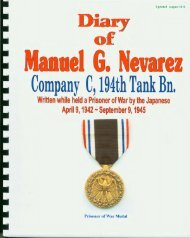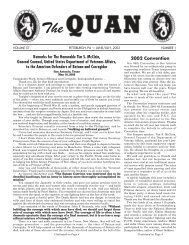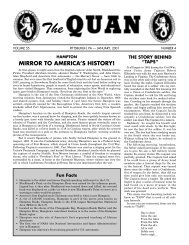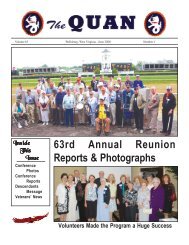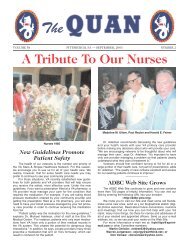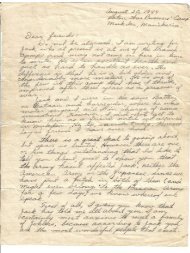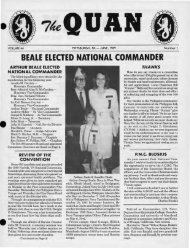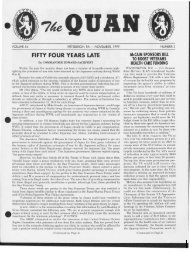95712 Quan Pages:95712 Quan Pages - Philippine Defenders Main
95712 Quan Pages:95712 Quan Pages - Philippine Defenders Main
95712 Quan Pages:95712 Quan Pages - Philippine Defenders Main
Create successful ePaper yourself
Turn your PDF publications into a flip-book with our unique Google optimized e-Paper software.
The Filipinos risked their lives to save the prisoners and<br />
defeat the Japanese.<br />
Francies, 87, took his latest trip recently, attending a ceremony<br />
for the 60th anniversary of the <strong>Philippine</strong>s liberation.<br />
The slim, blue-eyed vet marches yearly in Memorial Day<br />
parades and gives a slide show about his ordeal to students<br />
and civic groups. He also spoke twice daily during last year’s<br />
opening of the U.S. World War II Memorial in Washington, D.C.<br />
The death-march survivors are making a last stand. An<br />
estimated 60,000 of the 70,000 American and Filipino troops<br />
survived the ordeal, but only 200 were still alive last year,<br />
according to the military newspaper Stars & Stripes.<br />
Francies enlisted in the Army in 1937 and was assigned to<br />
fix radios and telephones with the 228th Signal Operations<br />
Corps. After Pearl Harbor, Washington sent few supplies or reinforcements<br />
to the Philip pines, which fell to Japanese invaders<br />
after a retreat to the Bataan peninsula.<br />
During the march, already undernourished prisoners were<br />
held in a camp for three days and marched for 11, in brutal<br />
sunshine with little water and no food. Locals tried to throw<br />
them food wrapped in banana leaves. The Japanese ordered<br />
them to stop — and killed some who continued.<br />
Many soldiers grew too weak to walk. The rest were too<br />
weak to carry them.<br />
“They would fall by the side of the road, only to be shot, but<br />
more often bayoneted,” Francies said. “There was nothing, nothing<br />
we could do but to look straight ahead and keep on walking.”<br />
Francies finally sneaked into bushes and collapsed. A<br />
Japanese medic secretly gave him a shot that revived him.<br />
The prisoners walked about 55 miles, rode awhile in airless<br />
railroad cattle cars, then marched a few more miles. Francies<br />
was too weak to remember the second walk.<br />
The prisoners finally reached Camp O’Donnell. The<br />
commandant said, “Forget you have names, forget you have<br />
parents, wives and children. Your loved ones no longer care,”<br />
Francies recalled.<br />
The prisoners finally got a little food — wormy, watery rice<br />
referred to as wall paper paste. Many were tortured. Some<br />
were beaten or stuck in tiny cages. Others, including Francies,<br />
had to bury comrades who were unconscious but not yet dead.<br />
When some prisoners escaped, Francies and others were<br />
interrogated and threatened on a firing line for six hours.<br />
Soon he got better work fixing radios — or mostly sabotaging<br />
them and smuggling parts to the <strong>Philippine</strong> resistance.<br />
Francies endured dysentery, malaria and two cases of<br />
appendicitis, only one of them treated by a POW medic. He<br />
lost about a third of his 160 pounds.<br />
He eventually survived a crammed voyage to Japan and<br />
worked at a copper mine that was hidden in the hills.<br />
When the commander finally announced the war’s end, the<br />
prisoners quickly painted “500 POWs” in yellow on the camp<br />
roof. Then they experienced a little of what they had missed in<br />
three years — a B-29 Superfortress swooped overhead and<br />
dropped something called penicillin.<br />
“Penicillin?” the prisoners painted on the roof. A plane<br />
dropped off instructions the next day.<br />
After the war, Francies spent several months in veterans<br />
hospitals. He said many of his countrymen refused to believe<br />
stories of Japanese torture.<br />
No group of men could have been treated that badly, they<br />
scoffed.<br />
Francies eventually recovered his health and used his electronic<br />
skills for 35 years installing telephones.<br />
He first returned to the <strong>Philippine</strong>s in 1982, during the 40th<br />
anniversary of the nation’s fall. He went again in 1997 and in<br />
each of the past four years, sometimes with his two daughters<br />
or with friends. He travels with Valor Tours, a San Francisco<br />
business.<br />
26 — THE QUAN<br />
Memories of Kindness<br />
(Continued from Page 14)<br />
The company’s Vicki Middagh says he is her last customer<br />
from among death-march survivors.<br />
“They’re just getting too old to travel,” Middagh said. “But<br />
the sons and daughters and now the grandkids are taking over<br />
for them.”<br />
Francies plans to keep going “as long as my health holds<br />
up and my cash holds up.”<br />
At home, he keeps busy with the Kiwanis and veterans<br />
groups. He walks regularly and audits classes at Cleveland<br />
State University.<br />
Francies hates how the United States has turned the tables<br />
lately, holding untold numbers of prisoners indefinitely and<br />
apparently torturing some.<br />
“It just bring us down to Japan’s level,” he said.<br />
Many elderly veterans warn youngsters to be prepared for<br />
war. Francies wants them to be open to peace.<br />
“Nobody wins a war,” he said.<br />
————————<br />
Conduct Under Fire: Four American<br />
Doctors and Their Fight for Life as<br />
Prisoners of the Japanese, 1941-1945<br />
By John Glusman<br />
Reviewer: Jeffrey T. Munson (Dixon, IL)<br />
Author John A. Glusman has written a masterful book<br />
about the horrible conditions Allied POWs faced as prisoners<br />
of the Japanese. In particular, this book concentrates on the<br />
lives of four American doctors; Lt. George Ferguson, Lt. Fred<br />
Berley, Lt. John Jacob Bookman, and Lt. Murray Glusman. All<br />
were stationed in the <strong>Philippine</strong>s when the Japanese attacked<br />
shortly after the bombing of Pearl Harbor.<br />
After enduring the defeat of Bataan, and later Corregidor,<br />
some 78,000 American and Filipino POWs were forced to<br />
march over seventy miles in what became known as the<br />
Bataan Death March. For the next three and a half years,<br />
Ferguson, Berley, Bookman, and Glusman were at the mercy<br />
of their Japanese captors. Food and water rations were virtually<br />
non existent, beatings were barbaric, and the doctors did the<br />
best they could to help the sick and wounded with virtually no<br />
medical supplies at all.<br />
Eventually, the doctors were loaded aboard Japanese “Hell<br />
Ships”; overcrowded freighters converted into ships to carry<br />
POWs to mainland Japan. The conditions on the ships were<br />
worse than in the camps. Men were placed in vastly over -<br />
crowded and stifling holds, given virtually no food or water, and<br />
were unable to even lie down due to the crowding. But the<br />
greatest fear faced by the POWs was attack by American<br />
submarines. Once torpedoed, the Japanese were known to<br />
machine gun the surviving POWs in the water. Indeed, George<br />
Ferguson died when the ship he was on was torpedoed.<br />
Once in Japan, the remaining three doctors were once<br />
again placed in concentration camps where they tended the<br />
wounded and sick. But as time wore on, they soon began to<br />
see hundreds of American B-29 bombers winging above them.<br />
They surmised that the Americans must be close to winning<br />
the war. However, they still had to endure the firebomb raids of<br />
Kobe and Osaka that virtually destroyed cities. However, after<br />
the atomic bombing of Hiroshima and Nagasaki in August of<br />
1945, the Japanese finally surrendered, and John, Murray, and<br />
Fred were finally able to return home.<br />
This is a spectacular book. John Glusman does an excellent<br />
job of describing the fall of the <strong>Philippine</strong>s, the Bataan Death<br />
March, and the atrocities that the POWs faced at the hands of<br />
the Japanese. My favorite part of the book was the extremely<br />
vivid description of the firebombing raids on Japan in the spring<br />
of 1945. I give this book my highest recommendation. Read and<br />
see how four ordinary men from the heartland of the United<br />
States managed to survive against a brutal and unforgiving<br />
enemy.



